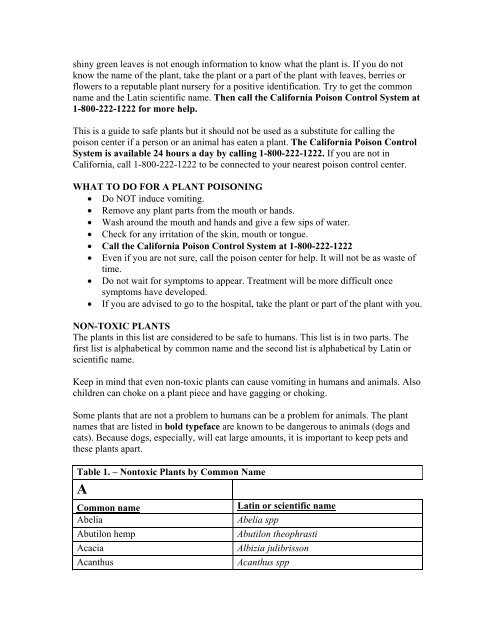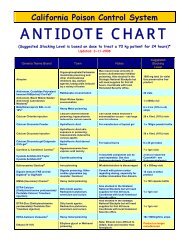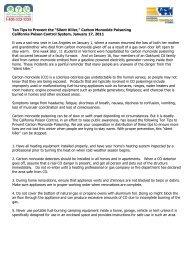KNOW YOUR PLANTS - California Poison Control System
KNOW YOUR PLANTS - California Poison Control System
KNOW YOUR PLANTS - California Poison Control System
You also want an ePaper? Increase the reach of your titles
YUMPU automatically turns print PDFs into web optimized ePapers that Google loves.
shiny green leaves is not enough information to know what the plant is. If you do not<br />
know the name of the plant, take the plant or a part of the plant with leaves, berries or<br />
flowers to a reputable plant nursery for a positive identification. Try to get the common<br />
name and the Latin scientific name. Then call the <strong>California</strong> <strong>Poison</strong> <strong>Control</strong> <strong>System</strong> at<br />
1-800-222-1222 for more help.<br />
This is a guide to safe plants but it should not be used as a substitute for calling the<br />
poison center if a person or an animal has eaten a plant. The <strong>California</strong> <strong>Poison</strong> <strong>Control</strong><br />
<strong>System</strong> is available 24 hours a day by calling 1-800-222-1222. If you are not in<br />
<strong>California</strong>, call 1-800-222-1222 to be connected to your nearest poison control center.<br />
WHAT TO DO FOR A PLANT POISONING<br />
• Do NOT induce vomiting.<br />
• Remove any plant parts from the mouth or hands.<br />
• Wash around the mouth and hands and give a few sips of water.<br />
• Check for any irritation of the skin, mouth or tongue.<br />
• Call the <strong>California</strong> <strong>Poison</strong> <strong>Control</strong> <strong>System</strong> at 1-800-222-1222<br />
• Even if you are not sure, call the poison center for help. It will not be as waste of<br />
time.<br />
• Do not wait for symptoms to appear. Treatment will be more difficult once<br />
symptoms have developed.<br />
• If you are advised to go to the hospital, take the plant or part of the plant with you.<br />
NON-TOXIC <strong>PLANTS</strong><br />
The plants in this list are considered to be safe to humans. This list is in two parts. The<br />
first list is alphabetical by common name and the second list is alphabetical by Latin or<br />
scientific name.<br />
Keep in mind that even non-toxic plants can cause vomiting in humans and animals. Also<br />
children can choke on a plant piece and have gagging or choking.<br />
Some plants that are not a problem to humans can be a problem for animals. The plant<br />
names that are listed in bold typeface are known to be dangerous to animals (dogs and<br />
cats). Because dogs, especially, will eat large amounts, it is important to keep pets and<br />
these plants apart.<br />
Table 1. – Nontoxic Plants by Common Name<br />
A<br />
Common name<br />
Latin or scientific name<br />
Abelia Abelia spp<br />
Abutilon hemp Abutilon theophrasti<br />
Acacia Albizia julibrisson<br />
Acanthus Acanthus spp








